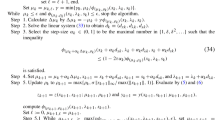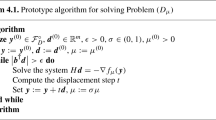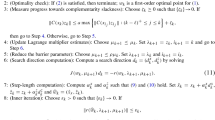Abstract
In this paper, we deal with primal-dual interior point methods for solving the linear programming problem. We present a short-step and a long-step path-following primal-dual method and derive polynomial-time bounds for both methods. The iteration bounds are as usual in the existing literature, namely\(O(\sqrt n L)\) iterations for the short-step variant andO(nL) for the long-step variant. In the analysis of both variants, we use a new proximity measure, which is closely related to the Euclidean norm of the scaled search direction vectors. The analysis of the long-step method depends strongly on the fact that the usual search directions form a descent direction for the so-called primal-dual logarithmic barrier function.
Similar content being viewed by others
References
Karmarkar, N. K.,A New Polynomial-Time Algorithm for Linear Programming, Combinatorica, Vol. 4, pp. 373–395, 1984.
Gill, P. E., Murray, W., Saunders, M. A., Tomlin, J. A., andWright, M. H.,On Projected Newton Barrier Methods for Linear Programming and an Equivalence to Karmarkar's Projective Method, Mathematical Programming, Vol. 36, pp. 183–209, 1986.
Fiacco, A. V., andMcCormick, G. P.,Nonlinear Programming: Sequential Unconstrained Minimization Technique, John Wiley and Sons, New York, New York, 1968.
Gonzaga, C. C.,An Algorithm for Solving Linear Programming Problems in O(n 3 L)Operations, Progress in Mathematical Programming, Interior Point and Related Methods, Edited by N. Megiddo, Springer Verlag, New Yor, New York, pp. 1–28, 1989.
Gonzaga, C. C.,Large-Step Path-Following Methods for Linear Programming, Part 1: Barrier Function Method, SIAM Journal on Optimization, Vol. 1, pp. 268–279, 1991.
Roos, C., andVial, J. P.,Long Steps with the Lagarithmic Penalty Barrier Function in Linear programming, Economic Decision Making: Games, Economics, and Optimization, Edited by J. Gabszevwicz, J. F. Richard, and L. Wolsey, Elsevier Science Publishers, Amsterdam, Holland, pp. 433–441, 1990.
Roos, C., andVial, J. P.,A Polynomial Method of Approximate Centers for Linear Programming, Mathematical Programming, Vol. 54, pp. 295–305, 1992.
Anstreicher, K. M.,On Long-Step Path-Following and SUMT for Linear and Quadratic Programming, Working Paper, Department of Operations Research, Yale University, New Haven, Connecticut, 1990.
Mylander, W. C., Holmes, R. L., andMcCormick, G. P.,A Guide to SUMT, Version 4: The Computer Program Implementing the Sequential Unconstrained Minimization Technique for Nonlinear Programming, Research Paper RAC-P-63, Research Analysis Corporation, McLean, Virginia, 1971.
McCormick, G. P.,The Projective SUMT Method for Convex Programming, Mathematics of Operations Research, Vol. 14, pp. 203–223, 1989.
Kojima, M., Mizuno, S., andYoshise, A.,A Primal-Dual Interior-Point Algorithm for Linear Programming, Progress in Mathematical Programming, Interior Point and Related Methods, Edited by N. Megiddo, Springer Verlag, New York, New York, pp. 29–47, 1989.
Monteiro, R. D. C., andAdler, I.,Interior Path-Following Primal-Dual Algorithms, Part 1: Linear Programming, Mathematical Programming, Vol. 44, pp. 27–41, 1989.
Kojima, M., Mizuno, S., andYoshise, A., An\(O(\sqrt n L)\) Iteration Potential Reduction Algorithm for Linear Complementarity Problems, Mathematical Programming, Vol. 50, pp. 331–342, 1991.
Kranich, E.,Interior-Point Methods for Mathematical Programming: A Bibliography, Diskussionsbeitrag No. 171, Fern Universität Hagen, Hagen, Germany, 1991.
Lustig, I. J., Marsten, R. E., andShanno, D. F.,Computational Experience with a Primal-Dual Interior-Point Method for Linear Programming, Linear Algebra and Its Applications, Vol. 152, pp. 191–222, 1991.
McShane, K. A., Monma, C. L., andShanno, D. F.,An Implementation of a Primal-Dual Interior-Point Method for Linear Programming, ORSA Journal on Computing, Vol. 1, pp. 70–83, 1989.
Mehrotra, S.,On the Implementation of a Primal-Dual Interior-Point Method, SIAM Journal on Optimization, Vol. 2, pp. 575–601, 1992.
Kojima, M., Mizuno, S., andYoshise, A.,A Primal-Dual Interior-Point Algorithm for a Class of Linear Complementarity Problems, Mathematical Programming, Vol. 44, pp. 1–26, 1989.
Ding, J., andLi, T. Y.,An Algorithm Based on Weighted Logarithmic Barrier Functions for Linear Complementarity Problems, Arabian Journal for Science and Engineering, Vol. 15, pp. 679–685, 1990.
Den Hertog, D., Roos, C., andVial, J. P.,A Complexity Reduction for the Long-Step Path-Following Algorithm for Linear Programming, SIAM Journal on Optimization, Vol. 2, pp. 71–87, 1992.
Gonzaga, C. C.,Path-Following Methods for Linear Programming, SIAM Review, Vol. 34, pp. 167–224, 1992.
Den Hertog, D.,Interior-Point Approach to Linear, Quadratic, and Convex Programming: Algorithms and Complexity, Kluwer Publishers, Dordrecht, The Netherlands, 1993.
Nesterov, Y. E., andNemirovsky, A. S.,Interior-Point Polynomial Methods in Convex Programming: Theory and Algorithms, SIAM Publications, Philadelphia, Pennsylvania, 1994.
Monteiro, R. D. C., andAdler, I.,Interior Path-Following Primal-Dual Algorithms, Part 2: Convex Quadratic Programming, Mathematical Programming, Vol. 44, pp. 43–66, 1989.
Ling, P. D., Private Communication, University of East Anglia, Norwich, England, 1992.
Papadimitriou, C. H., andSteiglitz, K.,Combinatorial Optimization: Algorithms and Complexity, Prentice-Hall, Englewood Cliffs, New Jersey, 1982.
Author information
Authors and Affiliations
Additional information
Communicated by L. C. W. Dixon
This work was supported by a research grant from Shell, by the Dutch Organization for Scientific Research (NWO) Grant 611-304-028, by the Hungarian National Research Foundation Grant OTKA-2116, and by the Swiss National Foundation for Scientific Research Grant 12-26434.89.
Rights and permissions
About this article
Cite this article
Jansen, B., Roos, C., Terlaky, T. et al. Primal-dual algorithms for linear programming based on the logarithmic barrier method. J Optim Theory Appl 83, 1–26 (1994). https://doi.org/10.1007/BF02191759
Issue Date:
DOI: https://doi.org/10.1007/BF02191759




